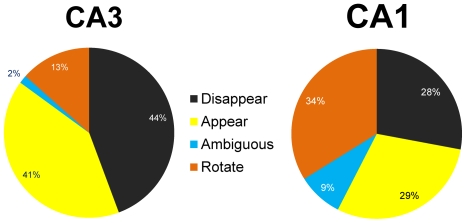Figure 5. Place field remapping.
When transitioning from the familiar to the novel environment, place fields exhibited a variety of remapping behaviors. Some cells maintained a place field in both familiar and novel environments located at different degrees of rotation around the rack (Rotate), while other cells had fields that turned on (Appear), turned off (Disappear), or split into multiple fields (Ambiguous). The pie chart depicts the percentage of cells in CA1 and CA3 that exhibited each type of place field remapping behavior. Only 15% of CA3 cells had place fields in both the familiar and novel environments, compared to 43% of CA1 cells.

